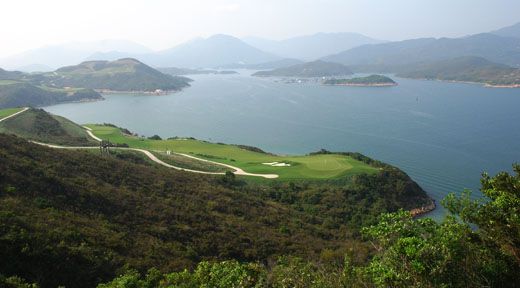 Looking back now, are there any other changes you would like to make? After all, the feedback on the course has been overwhelming positive.
Looking back now, are there any other changes you would like to make? After all, the feedback on the course has been overwhelming positive.
I would say that on almost every project we do there are at least one or two things we regret doing, not doing or not changing – the golf course can almost always be better at the end of the day and the East Course was no different. Either our design, or the implementation of the design, could almost always be improved upon. Unfortunately, and without passing the buck, there are always issues that conspire against you when you design a golf course: from the very short timeframe allowed, from limitations with the construction contract, from survey problems through to somewhat onerous environmental restrictions. All these factors combine with the steady and unstoppable force of a large construction project to limit a designer’s ability to make the best possible use of any site.
In the case of the East Course specifically: in a fantasy world where I could go back and change things there are a number of holes and features I would like to alter. In terms of routing, if we had worked harder to convince the club that a par 70 or 71 course was the best solution to this difficult site, I think could have made the course both stronger and better. Dropping the par to 71 would have enabled us to delete and convert the 18th into a par-3 par-4 combination instead of the somewhat forced par-5 that it is. There are a number of problems with this hole that are not easily solved with it as a par 5 – the landing area is too high relative to the second landing area. Sure, you could drop the landing area 10 metres to solve this but this would create its own problems with being able to tie the levels in to the hills on the left. As a par-3 playing to the current landing area, and then a short par 4, we could have solved the problems of a restricted landing area and less than perfect visibility for the second shot.
This change would mean that we have an extra hole and so deleting the par-3 15th would be my second routing change. It’s a nice enough little hole, with a beautiful green setting, but the teeing ground is forced and looks engineered. Deleting this hole would also mean that you could push the green at the par-4 14th back another 30 metres or so – right to the end of the ridgeline, which would strengthen and improve this hole as well and provide us with another strong par-4 on a course that lacks strong par 4s.
If we could step back even further and make the course a par 70, which is a difficult ask in Asia where owners have to have a par 72, I would also change the par-5 11th into a strong par-4, perhaps by sliding the green forward just a touch. This change would improve the strength of the course relative to par, although it wouldn’t make much of a difference to people’s scores.
I would like to take away a little of the engineered look of the course: there is just too much concrete out there, with U-drains at the top of every cut slope, which is mandated by Hong Kong law, although hopefully over time the native vegetation will disguise most of these. The bog standard power transformer poles are a real blight on the naturalness of the course, so I would ask the suppliers to think outside the box and supply us with something a little more discrete. Although we did make sure none were silhouetted against the skyline.
Discussing your Asian courses generally, how much freedom do you have in terms of design?
That’s an interesting question because on the one hand we get a lot of design freedom but it is within a set of very strict parameters. By this I mean owners, generally speaking, are very focused on a few critical numbers, which they see as very important, such as overall yardage (7200+) and par (72), yet they are less focused on the guts of the design, be that the strategy, the contouring, greens design and the like.
Owners will also often have one or two very strong desires or requests about what they would like to see on the golf course, such as an island green par-3 or more water on the course. Both of these are common requests, and although we always try and talk owners out of these things – we say: “Island greens are no longer unique since they are everywhere and they are too difficult for most players” and “water is an overused design element – how about some good solid strategic design instead?” – at the end of the day, the owner and our responsibility to them means we need to implement their desires as best we can while mitigating the negative effect on the golf course design.
With par and yardage, these are difficult prejudices to break down, since they are reinforced by the golf we see daily on TV being played by the pros of the PGA Tour. In the absence of a lot of golf experience on the part of the owners – and many of the owner’s do not know a lot about golf – the PGA Tour and the owner’s own professional golfer friends and advisors push for standard par and length solutions. This means that often better solutions with lesser par (70-71) and/or lesser yardage (6700-6900 yards) are sacrificed on the altar of “par 72, 7200 yard plus” solutions. The simple fact of the matter is that these sorts of yardages are too long for the vast majority of golfers.
Typically, how many times will you visit a project during the design and construction phases?
For most projects we will visit the site three to five times prior to finalising the course design, depending on the natural features of the site, including a field design trip where we review and/or conceptualize the design while in the field. Less pre-construction visits are typical if the site is totally flat with few natural features. During construction we are typically on site every four to eight weeks or so depending on site progress. On a typical project we will visit the site between 10 and 20 times.
Is there still a golf course boom in Asia?
For the moment it seems that the market in China is still strong, and there are small pockets of activity elsewhere, such as Vietnam and India, although both these countries have seen a drop off in activity recently. Long term, I think the potential is there for golf to continue to grow throughout Asia. It is after all a great game and one that engages the participant at many different levels. However, for growth to be sustainable, more public golf is definitely required, especially in China where the game remains quite elite. More participation and more success at the very top level by Chinese golfers should see the game grow in popularity.
And then there is the fact that you can gamble easily. Gambling between players of widely different standards is a great attractant for the average Chinese. Actually I think this one factor is the main reason why owners like to have an island green on their golf courses – it’s the type of hole that settles a lot of bets!
I heard that Nelson & Haworth has designed nearly 10 per cent of the courses in China
China is a huge place and we have been working there continuously through its ups and downs since 1992. In that time, the growth of the game has been breathtaking. The other night I was at a dinner with a Chinese friend and we were talking about the number of golf courses in China. I estimated there were 400 courses and my friend put the number at closer to 800, so the percentage of courses we have designed might vary quite a bit.
We have been very lucky in China in a number of ways. Firstly, we have been fortunate enough to work on some great, high profile sites with clients dedicated to quality – courses like Shenzhen Golf Club, Sheshan Golf Club in Shanghai and Bayhood No. 9 in Beijing. These projects all enjoy high profiles, not only due to the quality of the courses themselves, but also their great locations and the quality of their owners and management.
We have also been fortunate with both our people and the people we work with. Business in China is very much about relationships and friendships. From a company perspective, our partner, David Young, has helped a great deal in our relationships with our China clients. We have also been blessed to know a great many people in China who have helped us to win jobs by recommending us to their friends or bosses – a great many of our jobs have come to us through this method.
Pages
Click here to see the published article.











